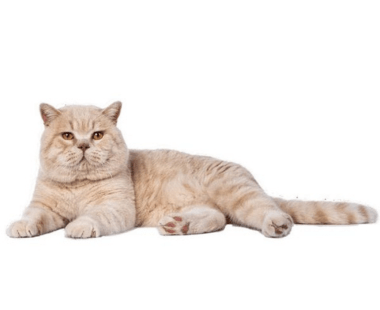Exotic
About the Breed
If you love the look of a Persian, but don’t have time for extensive grooming, there’s a breed designed just for you! The Exotic possesses every characteristic that makes a Persian so appealing—minus the longer-coat challenge! Instead, these adorable cats have luxuriously dense coats that are medium in length and stand off from their bodies, giving them the appearance of a fluffy feline teddy bear. In CFA, they are considered longhair cats because they are structurally identical to a Persian, but they are a bit easier to care for.
Breed History
Back in the 1950s, several West Coast Persian breeders crossed their cats with American Shorthairs. Since short hair is dominant over long hair, the result was a number of unusually charming shorthaired kittens with the rounded heads, expressive round eyes, and short, cobby bodies associated with Persians. Back then, these hybrids were considered extremely controversial. However, they proved so popular that in 1966, CFA decided to establish them as a breed. Because so many of these new shorthairs were shaded silver or chinchilla—colors which did not, at the time, exist in any shorthair breeds—the name chosen for the new breed was the Exotic Shorthair. The word “Shorthair” caused confusion and was eventually dropped; today the breed is simply known as the Exotic.
Balance and refinement are the essence of the breed, where all parts come together in a harmonious whole, with neither too much nor too little consideration given to any one feature.
For cats in the tabby division, the 20 points for color are to be divided 10 for markings and 10 for color. For cats in the bi-color division, the 20 points for color are to be divided 10 for "white" with pattern and 10 for color.
GENERAL
The ideal Exotic should present an impression of a heavily boned, well balanced cat with a sweet expression and soft, round lines. The large, round eyes set wide apart in a large round head contribute to the overall look and expression. The thick, plush coat softens the lines of the cat and accentuates the roundness in appearance.
HEAD
Round and massive, with great breadth of skull. Round face with round underlying bone structure. Well set on a short, thick neck. Skull structured to be smooth and round to the touch and not unduly exaggerated from the front view to the forehead begins at the top of the break to the back of the head, as well as across the breadth between the ears. When viewed in profile, the prominence of the eyes is apparent and the forehead, nose, and chin appear to be in vertical alignment.
NOSE
Short, snub, and broad, with "break" centered between the eyes.
CHEEKS
Full. Muzzle not overly pronounced, smoothing nicely into the cheeks.
JAWS
Broad and powerful.
CHIN
Full, well-developed, and firmly rounded, reflecting a proper bite.
EARS
Small, round tipped, tilted forward, and not unduly open at the base. Set far apart, and low on the head, fitting into (without distorting) the rounded contour of the head.
EYES
Brilliant in color, large, round, and full. Set level and far apart, giving a sweet expression to the face.
BODY
Of cobby type, low on the legs, broad and deep through the chest, equally massive across the shoulders and rump, with a well-rounded midsection and level back. Good muscle tone, with no evidence of obesity. Medium to large in size. Quality the determining consideration rather than size.
LEGS
Short, thick, and strong. Forelegs straight. Hind legs are straight when viewed from behind.
PAWS
Large, round, and firm. Toes carried close, five in front and four behind.
TAIL
Short, but in proportion to body length. Carried without a curve and at an angle lower than the back.
COAT
Dense, plush, and full of life. Standing out from the body due to a rich, thick undercoat. Medium in length. Acceptable length depends on proper undercoat.
DISQUALIFY
Locket or button. Kinked or abnormal tail. Incorrect number of toes. Any apparent weakness in the hind quarters. Any apparent deformity of the spine. Deformity of the skull resulting in an asymmetrical face and/or head. Crossed eyes.*
*The above listed disqualifications apply to all Exotic cats. Additional disqualifications are listed under "Colors".
WHITE: pure glistening white. Nose leather and paw pads: pink. Eye color: deep blue or brilliant copper. Odd-eyed whites shall have one blue and one copper eye with equal color depth.
BLUE: blue, lighter shade preferred, one level tone from nose to tip of tail. Sound to the roots. A sound darker shade is more acceptable than an unsound lighter shade. Nose leather and paw pads: blue. Eye color: brilliant copper.
BLACK: dense coal black, sound from roots to tip of fur. Free from any tinge of rust on tips or smoke undercoat. Nose leather: black. Paw pads: black or brown. Eye color: brilliant copper.
RED: deep, rich, clear, brilliant red; without shading, markings, or ticking. Lips and chin the same color as coat. Nose leather and paw pads: brick red. Eye color: brilliant copper.
CREAM: one level shade of buff cream, without markings. Sound to the roots. Lighter shades preferred. Nose leather and paw pads: pink. Eye color: brilliant copper.
CHOCOLATE: rich, warm chocolate-brown, sound from roots to tip of fur. Nose leather: brown. Paw pads: cinnamon-pink. Eye color: brilliant copper.
LILAC: rich, warm lavender with a pinkish tone, sound and even throughout. Nose leather and paw pads: lavender-pink. Eye color: brilliant copper.




